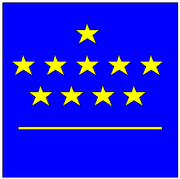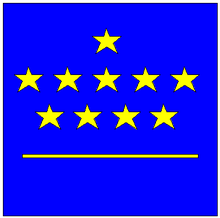Royal Observatory of Belgium
 | |
 | |
| Organization | Royal Observatory of Belgium |
|---|---|
| Observatory code | 012 |
| Location | Uccle (Ukkel (Dutch)) |
| Coordinates | 50°47′54″N 4°21′30″E / 50.79833°N 4.35833°E |
| Established | 1826 (Saint-Josse-ten-Noode) 1890 Uccle |
| Website | www www |
| Telescopes |
|
| | |
| see § List of discovered minor planets |
The Royal Observatory of Belgium (Template:Lang-nl; Template:Lang-fr), is situated in Uccle (Ukkel in Dutch) since 1890. It was first established in Saint-Josse-ten-Noode in 1826 by William I under the impulse of Adolphe Quetelet. It was home to a 100 cm diameter aperture Zeiss reflector in the first half of the 20th century, one of the largest telescopes in the world at the time. It owns a variety of other astronomical instruments, such as astrographs, as well as a range of seismograph equipment (such as for detecting earthquakes).
The main activities are:
- Reference systems and geodynamics
- Astrometry and dynamics of celestial bodies
- Astrophysics
- Solar physics.
History
Nineteenth Century
Adolphe Quetelet first petitioned the government of the United Kingdom of the Netherlands to establish an astronomical observatory in Brussels in 1823. William I granted his request in 1826 and construction started in 1827 in Saint-Josse-ten-Noode. Meteorological observations started early, but delivery and installation of astronomical equipment proceeded slowly. Quetelet was appointed astronomer in 1828.
During the Belgian Revolution fighting took place in and around the observatory. Quetelet kept his position under the new government and started scientific observations. By 1834 buildings and instruments were finally completed. Adolpe Quetelet was succeeded by his son Ernest upon his death in 1874.
In 1876 Jean-Charles Houzeau became the new director and immediately started planning a move to Uccle. He managed to obtain better funding, enlarged the scientific staff and completely renewed the instruments. The first Belgian astronomical expedition was sent to Santiago and San Antonio to observe the transit of Venus in 1882. He tried to separate the meteorological and astronomical departments, but this was refused by the government. In 1883 construction of a new observatory in Uccle started, but Houzeau's resignation in 1883 delayed the move which was only completed in 1890-1891.
Twentieth Century
Georges Lecointe was appointed as director in 1900, succeeding F. Folie and A. Lancaster. Under his leadership, seismological measurements started in 1901 and the first weather balloons were launched in 1906. Belgium participated in the Carte du Ciel and the Astrographic Catalogue; observations lasted until 1964. In 1913 the meteorological department finally became an independent entity, the Royal Meteorological Institute. After World War I the Central Bureau for Astronomical Telegrams was located in Uccle from 1920 to 1922 while it was headed by Lecointe.
Illness forced Lecointe to resign in 1925 and he was succeeded by Paul Stroobant.[2]
Since 1981, the Sunspot Index Data center, the World data center for the Sunspot Index is harbored at the observatory.[3]
The asteroid 1276 Ucclia is named for City and the Observatory.
The Planetarium is located at the Heysel, in the northern region of Brussels.
King Baudouin was an amateur astronomer and took a keen interest in the Royal Observatoy. After his death a statue in honour of the king was raised outside the entrance.
List of discovered minor planets
| (120140) 2003 GB21 | 3 April 2003 | list |
| (172419) 2003 GD21 | 4 April 2003 | list |
| (174625) 2003 ST76 | 19 September 2003 | list |
| (175069) 2004 GU28 | 15 April 2004 | list |
| (182910) 2002 EP99 | 2 March 2002 | list |
| (186664) 2003 YA30 | 18 December 2003 | list |
| (206440) 2003 SC210 | 25 September 2003 | list |
| (217332) 2004 RS79 | 8 September 2004 | list |
| (247727) 2003 GC21 | 4 April 2003 | list |
| (260089) 2004 KO17 | 27 May 2004 | list |
| (271133) 2003 SU76 | 19 September 2003 | list |
| (323074) 2002 TS96 | 10 October 2002 | list |
| (436000) 2009 FE46 | 17 March 2009 | list |
| Minor Planet Center as of 2016[1] | ||
|---|---|---|
See also
- Belgian Federal Science Policy Office
- Belgian Institute for Space Aeronomy
- List of minor planet discoverers § Discovering dedicated institutions
- Planetarium
- Royal Meteorological Institute
References
- ^ a b "Minor Planet Discoverers (by number)". Minor Planet Center. 14 November 2016. Retrieved 27 November 2016.
- ^ "Geschiedenis van Koninklijke Sterrenwacht van België" (in Dutch). Belgian Science Policy Office. 1 February 2007. Retrieved 21 October 2013.
- ^ "Solar Influences Data analysis center".
Further reading
- Centennial of the Royal Observatory Belgium (The Observatory, Vol. 58, p. 208-209 (1935))

